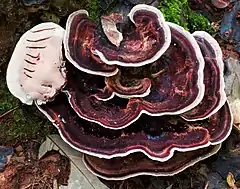| Nigroporus | |
|---|---|
 | |
| Nigroporus vinosus | |
| Scientific classification | |
| Kingdom: | |
| Division: | |
| Class: | |
| Order: | |
| Family: | |
| Genus: | Nigroporus Murrill (1905) |
| Type species | |
| Nigroporus vinosus (Berk.) Murrill (1905) | |
| Species | |
|
N. durus | |
Nigroporus is a genus of poroid fungi in the family Steccherinaceae.[1] The genus was circumscribed by American mycologist William Alphonso Murrill in 1905.[2] Nigroporus has a pantropical distribution.[3] The genus name combines the Latin word niger ("black") with the Ancient Greek word πόρος ("pore").[4]
Description
The fruit bodies of Nigroporus fungi are annual to perennial. Their form ranges from pileate (with a cap) to crust-like. When a cap is present, it is scrupose (rough with very small hard points) to smooth, and sometimes with concentric zones. The colour is greyish-blue, vinaceous-brown to pink or violet. The pore surface has the same colours as the cap; pores are usually small and round to angular. The context is vinaceous brown to pink and purplish.[3]
The hyphal system is dimitic, meaning it contains both generative and skeletal hyphae. The generative hyphae have clamp connections; the skeletal hyphae are brownish, and thick-walled to solid. There are no cystidia in the hymenium. The spores are mostly small, with their longest dimension typically less than 5 µm. They are smooth and thin-walled, hyaline (translucent), with an allantoid (long with rounded ends) to broadly ellipsoid shape.[3]
Species
- Nigroporus durus (Jungh.) Murrill (1907)[5]
- Nigroporus macroporus Ryvarden & Iturr. (2004)[6]
- Nigroporus scalaris (Fr.) Ryvarden (1972)[7]
- Nigroporus stipitatus Douanla-Meli & Ryvarden (2007)[8]
- Nigroporus ussuriensis (Bondartsev & Ljub.) Y.C.Dai & Niemelä (1995)[9]
- Nigroporus vinosus (Berk.) Murrill (1905)[2]
References
- ↑ Miettinen, Otto; Larsson, Ellen; Sjökvist, Elisabet; Larsson, Karl-Henrik (2012). "Comprehensive taxon sampling reveals unaccounted diversity and morphological plasticity in a group of dimitic polypores (Polyporales, Basidiomycota)". Cladistics. 28 (3): 251–270. doi:10.1111/j.1096-0031.2011.00380.x. PMID 34872189. S2CID 84643554.
- 1 2 Murrill, William A. (1905). "The Polyporaceae of North America: XI. A synopsis of the brown pileate species". Bulletin of the Torrey Botanical Club. 32 (7): 353–371. doi:10.2307/2478499. JSTOR 2478499.
- 1 2 3 Ryvarden L, Johansen I (1980). A preliminary polypore flora of East Africa. Synopsis Fungorum. Oslo, Norway: Fungiflora. p. 446.
- ↑ Donk, M.A. (1960). "The generic names proposed for Polyporaceae". Persoonia. 1 (2): 173–302.
- ↑ Murrill, William A. (1907). "Some Philippine Polyporaceae". Bulletin of the Torrey Botanical Club. 34 (9): 465–481. doi:10.2307/2479067. JSTOR 2479067.
- ↑ Ryvarden, Leif; Iturriaga, Teresa (2003). "Studies in neotropical polypores 10. New polypores from Venezuela". Mycologia. 95 (6): 1066–1077. doi:10.1080/15572536.2004.11833021. JSTOR 3761913. PMID 21149014. S2CID 42996705.
- ↑ Ryvarden, L. (1972). "A critical checklist of the Polyporaceae in tropical East Africa". Norwegian Journal of Botany. 19 (3–4): 229–238.
- ↑ Douanla-Meli, Clovis; Ryvarden, Leif; Langer, Ewald (2007). "Studies of tropical African pore fungi (Basidiomycota, Aphyllophorales): three new species from Cameroon". Nova Hedwigia. 84 (3–4): 409–420. doi:10.1127/0029-5035/2007/0084-0409.
- ↑ Dai, Y.C.; Niemelä, T. (1995). "Changbai wood-rotting fungi 4. Some species described by A.S. Bondartsev and L.V. Lyubarsky from the Russian Far East". Annales Botanici Fennici. 32 (4): 211–226.